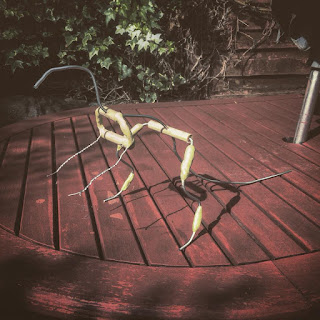I decided to scrap it and start again, this time using wooden dowelling to act as solid 'bones' or grab points. I was still going to utilise the 'build-up' technique (the same technique Marcel Delgado used on "King Kong"), which involves making a puppet without the use of an existing sculpture to cast from, and has the foam built directly over the armature. You can get great results with build-up models (eg. Jim Danforth's 'Mother Dino' from "When Dinosaurs Ruled the Earth"), however if you are wanting a model that can be easily duplicated or if multiple identical characters are required, then a silicone/latex cast puppet would be better suited.
The T-Rex armature Mk. 2. I used Milliput epoxy putty for the leg bones.
Foot armatures (photo taken later on).
This was then covered in upholstery foam to block out the anatomy of the dino, and glued with spray adhesive. I also made a wooden skull with an articulated jaw (wire). The feet were also wood and wire, with a tie down nut inserted into the base.
I sculpted the head and some skin textures in Monster Clay (a fantastic product for sculpting!) and made plaster moulds of these (Crystacal), the head being a two-part mould. The previous model I attempted had an entirely built up head over a wooden skull, and although it looked good, I knew I could get better and more detailed results with a carefully sculpted and cast head.
Original Monster Clay sculpture.
Two-part plaster head mould.
I then made tinted latex castings from these moulds and the results were pretty darn good! Latex is a great cheap material, but does have a shorter life expectancy than silicone rubber. A lot of latex/foam latex models (a thicker consistency of latex that fills the entire mould and surrounds the armature), tend to deteriorate after a while. Sadly a good number of Ray Harryhausen's iconic creations have rotted away over the years, but restoration work has been carried out to save them.
Once the armature had been padded out with foam, and shaped with scissors and foam bandage wrap, I then started layering the latex skin, which was then dry brushed with a highlight colour. To hide seam lines, I used drops of tinted latex to create wrinkles and other skin textures. The claws on the fingers and toes were sculpted with Milliput and sharpened with a Dremel tool. I also used toothpicks to make teeth and these were glued in with superglue.
Tinted latex head casting.
Foam padding.
I do hope to use this critter in my short film, though I think a replacement may be in order with some armature adjustments, such as the placement of the tie-down nut, which should really be near the middle of the foot, to allow for a smooth foot lift/landing in animation.
Next I shall cover the second stop motion 'star' I have been making!
































